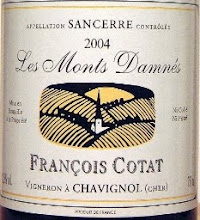Rendez-vous was given: Caves Legrand, October 19th. For the second time this year, I was going to spend some time with one of the most interesting winemakers you can find: Anselme Selosse.
Anselme started with a quick introduction on his domain. Located in Avize, he took over his father after his studies in Burgundy which he says had an impact on the way he's working. He conducted a biodynamic agriculture from 1995 to 2001 and quit because he wanted more freedom while still respecting the vines.
 Interestingly, when asked about the people who influence him he mentions 4 names:
Interestingly, when asked about the people who influence him he mentions 4 names:-Didier Barral from Faugeres because of the way he brought an entire ecosystem in his vineyards
-Sylvain Pitiot from Clos de Tart
-Claude Bourguignon (soil expert)
-Jean Marie Pelt, French botanist who founded the European Institute of Ecology

When the date of this dinner was set up, Anselme disgorged (last March) 6 bottles of his 2003 vintage. Because he wanted to show us the impact of the dosage, after disgorging those 6 bottles he used a different dosage for each of those: no dosage, 0.06 cl, 0.12 cl, 0.18 cl, 0.24 cl and .30cl.
One important thing to realise is that even for the highest dosage here, we are still in the Extra-Brut category and Selosse Champagnes are always very low in dosage.
So here we go on this dosage class, just like Anselme did when he choosed what he was going to do with his 2003 vintage: try different combinations and see the one(s) with the most balance.
For my part, I really enjoyed the 1st one (no dosage) and the 4th one (0.18cl). The last 2 I thought we too heavy and were almost sticking to your palate (even though once again it is still a very low dosage). The 2nd and 3rd were not bad but you could sense something was missing.
Anselme eventually picked the 4th one for his 2003 vintage (o.18cl).
It was really interesting to see the impact of the dosage. To me a few things stood out:
-It seems like he has an impact on the oxidative character: the more dosage you have, the less oxidative character you feel (white chocolate, quince) and the less dosage you have, the more oxidative character you sense (curry notes).
-Also, it looks like it has a light impact on the effervescence: it is less bubbly with low dosage.
Again those are my impressions on those very particular bottles. It would be interesting to check this out on other producers.
Then, we were treated with 5 different Selosse vintages: 2005, 2003, 2002, 1999 and 1998.
His vintage always sees 50% of new wood and comes from 2 parcelles in Avize (100% Chardonnay): Chanterelle (oriented East) and Maladri (Coteau, oriented South). All the champagnes were disgorged the day before the dinner and were not dosed.
The 2005 showed some butter and light vanilla. Very Burgundian, got better with air gaining balance. Needs time.
The 2002 showed honey and spices along exotic fruits.
The 1999, wine that I've been lucky to have a few times now, is a very solar champagne (14.5%!). It is quite opulent, quince but again some minerality appears with air and give freshness to the wine.
The 1998 starts to show truffle notes with a hint of exotic fruits.
There's also in every wines a light and refreshing bitterness on the finish. Anselme mentioned that this is partly due because of the slow pressurage he's doing. Overall I believe, but this is personal, that his vintage Champagnes need time to acquire the perfect balance and to allow the mineral spine, so precious to Anselme and true to Avize, to reveal itself.
Another unforgettable moment with Anselme.



No comments:
Post a Comment